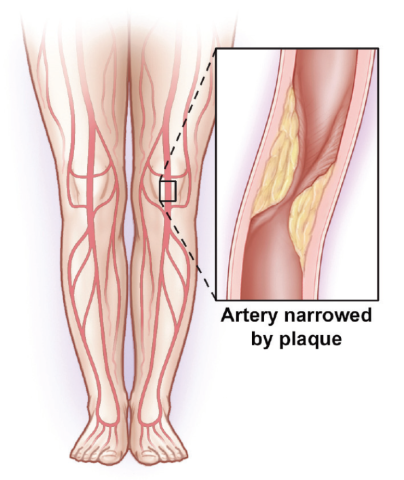Patients with Claudication
Condition

Claudication is defined as leg pain with walking that
is relieved by rest. The pain occurs most commonly
in the calf or the hips and buttocks. Claudication is
due to reduced blood flow to the muscles
during activity.
Peripheral Artery Disease (PAD), a blockage of the
arteries, is the main cause of Claudication. About 6.5
million Americans over 40 years of age have PAD.
The risk of PAD increases with age, cigarette smoking,
and in people with diabetes.
Initial management of Claudication consists of lifestyle
modification, smoking cessation, targeted medical
management, and exercise therapy. Percutaneous or
surgical intervention may be needed when symptoms
are disabling and do not improve with conservative care.
When to Refer
The Society for Vascular Surgery (SVS) has created disease-specific guidelines to assist in the care of patients with lower extremity atherosclerotic occlusive disease, including Claudication. The SVS emphasizes a multidisciplinary approach to PAD, encouraging collaboration between Primary Care Physicians and Vascular Surgeons to tailor treatment for each patient.
Patients should be referred to a vascular surgeon when their symptoms are severe or progress. Individuals whose lifestyle is limited due to Claudication may be candidates for intervention. Because patients with PAD are at increased risk for myocardial infarction (heart attack) and stroke, treatment should be directed to address their
overall vascular health.
Why to Refer to a Vascular Surgeon
Vascular surgery is the only discipline among the American Board of Medical Specialties which has specific training requirements to study the natural history, medical treatment, minimally invasive treatment, and
surgical options for your patients. A vascular surgeon can be your partner to help you and your patients get the most comprehensive management of their vascular disorder as well as the treatment that is best for them. Early referral and collaboration with a vascular surgeon can lead to better outcomes for each patient.
Claudication Clinical Practice Guidelines
Screening of appropriate populations at increased risk of PAD is recommended; ultrasound is the preferred imaging tool:
- ABI (ankle-brachial index) is used as the first-line noninvasive test for patients with signs or symptoms suggestive of peripheral artery disease.
- When the ABI is normal (>0.9) and symptoms of Claudication are present, exercise ABI is recommended.
- Asymptomatic individuals at elevated risk (age >70, smokers, diabetics, established cardiovascular disease or abnormal pulse exam) should undergo ABIs to improve risk stratification, preventive care, and medical management.
Recommendations for the management of patients with asymptomatic PAD:
In asymptomatic patients, the focus of management centers on modifying risk factors:
- Recommend multidisciplinary comprehensive smoking cessation.
- Recommend providing education about the signs and symptoms of PAD progression.
- Recommend against invasive treatment for PAD in the absence of symptoms.
Recommendations for the management of patients with symptoms of Claudication:
While symptomatic patients should also be counseled to stop smoking, additional treatment strategies include:
- Patients should be prescribed an anti-platelet agent and a statin.
- First-line therapy should consist of a supervised exercise program with walking a minimum of three times per week (30-60 min/session) for at least 12 weeks.
- Early referral to a vascular surgeon is encouraged for initial management as well as consideration of revascularization based on the patient’s response to noninvasive therapies.